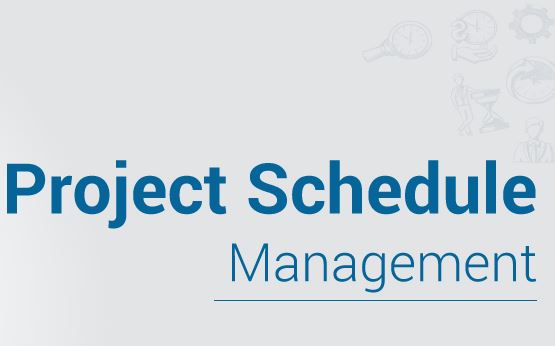
Project Schedule Management Summary 6th Edition
27 June 2020Project Schedule Management Summary 6th Edition
- The detailed project schedule should remain flexible throughout the project life cycle.
- There are two main practicing for scheduling methods:
✓ Iterative scheduling with a backlog:
➢ It is a form of rolling wave planning based on adaptive life cycles.
➢ The benefit of this approach is that it welcomes changes throughout the development life cycle.
✓ On-demand scheduling:
➢ Used in a Kanban system. On-demand scheduling does not rely on a schedule that was developed previously but pulls work from a backlog as resources become available.
➢ It’s used in projects that evolve the product incrementally in operational environment.
- If a business analyst is assigned to a project, requirement-related activities are the responsibility of that role.
- Release and iteration length: In adaptive life cycle the time-boxed periods for releases, waves and iterations are specified.
- Time-boxed periods: durations which the team works steadily toward completion of a goal, and this helps to minimize scope creep.
- Define Activities Outputs:
✓ Activity List :
➢ Includes the schedule activities required on the project.
➢ Projects that use agile/rolling wave techniques the activity list will be updated periodically.
➢ Activity list includes activity identifier and scope of work description for each activity.
✓ Activity Attributes :
➢ Identifies component associated with each activity which evolves over time.
➢ At early stages it will include activity identifier, WBS ID, and activity name.
➢ At later stages/completed will include descriptions, predecessor, activities, successor activities, logical relationships, leads and lags resource requirements, constraints, and assumptions.
✓ Milestone List:
➢ Significant point or event in a project which has zero duration.
➢ They can be mandatory (required by contract) or optional.
- Precedence Diagramming Method (PDM):
✓ Technique used for constructing a schedule model in which activities are represented by nodes and are graphically linked by one or more logical relationships to show the sequence in which the activities are to be performed.
✓ Finish-to-start (FS) is the most commonly used type of precedence relationship .
✓ Two activities can have two logical relationships at the same time. However Multiple relationships between the same activities are not recommended.
- Dependency Determination and Integration:
✓ Mandatory dependencies: are legally or contractually required. They often involve physical limitations. They often called “hard logic or hard dependencies”.
✓ Discretionary dependencies: are established based on knowledge of best practices. Discretionary dependencies also called “logic, preferential logic, or soft logic).
✓ External dependencies: involve a relationship between project activities and non-project activities and usually outside the project team’s control.
✓ Internal dependencies: involve a precedence relationship between project activities and are generally inside the project team’s control.
- Leads and Lags:
✓ Lead is the amount of time a successor activity can be advanced with respect to a predecessor activity. Lead is often represented as a negative value for lag in scheduling software.
✓ Lag is the amount of time a successor activity will be delayed with respect to a predecessor activity. And it is often represented as a Positive value for lag in scheduling software.
- Activities that have multiple predecessor activities indicate a path convergence. Activities that have multiple successor activities indicate a path divergence.
- There are factors to consider when estimating the duration:
✓ Law of diminishing returns: When one factor used to determine the effort required to produce a unit of work is increased while all other factors remain fixed a point .
✓ Number of resources: Increasing the number of resources to twice the original number of the resources does not always reduce the time by half, as it may increase extra duration due to risk.
✓ Advances in technology: Increase in the output of a manufacturing plant may be achieved by procuring the latest advances in technology may impact duration and resource needs.
✓ Motivation of staff: Project manager also needs to be aware of Student Syndrome (procrastination), when people start to apply themselves only at the last possible moment before the deadline.
❖ Parkinson’s Law where work expands to fill the time available for its completion.
- Analogous Estimating :
✓ Technique for estimating the duration or cost of an activity or a project using historical data. It uses parameters from previous projects.
✓ This technique is used when there is a limited amount of detailed information about the project.
✓ Less costly and less time-consuming than other techniques but it is also less accurate.
- Parametric Estimating:
✓ Technique in which an algorithm is used to calculate cost or duration based on historical data and project parameters .
✓ Uses a statistical relationship between historical data and other variables to calculate activity duration and cost.
- Three-Point Estimating:
✓ Using three-point estimates helps define an approximate range for an activity’s duration.
✓ Most likely (TM), Optimistic (TO) and Pessimistic (TP).
✓ Expected duration:
❖ Triangular distribution: TE= (TO + TM + TP) / 3
❖ Triangular distribution is used when there is insufficient historical data or when using judgmental data. This technique provides an expected duration and clarify the range of uncertainty
❖ Beta Distribution (PERT): TE= (TO + 4TM +TP) / 6
- Bottom-Up Estimating:
✓ Method of estimating project duration or cost by aggregating the estimates of the lower level components of the WBS.
✓ If an activity duration can’t be estimated with reasonable confidence, the work within the activity is decomposed into more detail.
✓ These estimates are then aggregated into a total quantity for each of the activity’s durations.
- Reserve analysis:
✓ Determine the amount of contingency and management reserve needed for the project.
✓ Contingency reserves are associated with the known-unknowns (unknown amount of work). It may be a percentage of estimated activity duration or fixed number of work periods.
✓ Management reserves are a specified amount of the project budget withheld for management control purposes and are reserved for unforeseen work that is within scope of the project. It addresses unknown-unknowns that can affect a project.
❖ Management reserve is not included in the schedule baseline but it is part of the overall project duration requirements.
- Schedule Network Analysis:
✓ Technique used to generate the project schedule model and it’s an iterative process.
✓ Assessing the need to aggregate schedule reserves to reduce the probability of a schedule slip.
✓ Employs several other techniques such as critical path method, resource optimization techniques and modeling techniques.
- Critical Path Method (CPM):
✓ The critical path estimates the minimum project duration and determine the amount of schedule flexibility on the logical network paths within the schedule model.
✓ The critical path is the sequence of activities that represents the longest path through a project, which determines the shortest possible project duration.
✓ Total float (slack) is the amount of time an activity can be delayed without delaying the project completion date. On a critical path the total float is zero.
✓ Free float is the amount of time that a schedule activity can be delayed without delaying the early start date of any successor or violating a schedule constraint.
✓ Positive total float is caused when the backward pass is calculated from a schedule constraint that is later than the early finish date that has been calculated during forward pass calculation.
✓ Negative total float is caused when a constraint on the late dates is violated by duration and logic. Negative float analysis is a technique that helps to find possible accelerated ways of bringing a delayed schedule back on track.
- Resource Optimization:
✓ Resource leveling: A technique in which start and finish dates are adjusted based on resource constraints with the goal of balancing the demand for resources with the available supply. Resource leveling can often cause the original critical path to change. Available float is used for leveling resources.
✓ Resource Smoothing: A technique that adjusts the activities of a schedule model such that the requirements for resources on the project do not exceed certain predefined resource limits. Critical path is not changed and the completion date may not be delayed. Resource smoothing is very similar to resource leveling except smoothing uses total and free float.
- What-if scenario analysis:
✓ process of evaluating scenarios in order to predict their effect (positive or negative) on the project.
✓ It helps in assessing the feasibility and address the impact on unexpected situations.
- Schedule Compression: techniques are used to shorten or accelerate the schedule duration without reducing the project scope in order to meet schedule constraints, imposed dates, or other schedule objectives. Techniques that can be used:
✓ Crashing: Technique used to shorten the schedule duration for the least incremental cost by adding resources. Examples (overtime, additional resources). Crashing works only for activities on the critical path where additional resources will shorten the activity’s duration. Crashing does not always produce a viable alternative and may result in increased risk and/or cost.
✓ Fast Tracking: compression technique in which activities or phases normally done in sequence are performed in parallel for at least a portion of their duration. Fast tracking may result in rework and increased risk.
Fast tracking only works when activities can be overlapped to shorten duration at critical path. Fast tracking may also increase project costs.
- Agile Release Planning : Provides a high-level summary timeline of the release schedule. determines the number of iterations or sprints in the release, and allows the product owner and team to decide how much needs to be developed .
- Develop Schedule Outputs:
✓ Schedule Baseline: Approved version of a schedule model that can be changed only through formal change procedure and used as comparison to actual results.
✓ Project Schedule: Output of a schedule model that presents linked activities with planned dates, durations milestones, and resources. The project schedule may be presented in summary form, sometimes referred
to as the master schedule or milestone schedule.
- Project schedule is usually presented in graphical form (Bar charts (Gantt Charts), Milestone charts and Project schedule network diagrams (Pure logic diagram)).
- Schedule Data: collection of information for describing and controlling the schedule incudes (milestones, activities, attributes and documentation for assumptions and constraints).
- Earned Value Analysis: Schedule performance measurements such as schedule variance (SV) and schedule performance index (SPI) are used to asses magnitude of variation to original baseline.
- Iteration Burndown Chart: This chart tracks the work that remains to be completed in the iteration backlog.
- Performance reviews: Measure, compare, and analyze schedule performance against the schedule baseline.
- Schedule Forecasts:
✓ Estimates or predictions of conditions and events in the project’s future based on information and knowledge available at the time of the forecast.
✓ The information is based on the project’s past performance and expected future performance based on corrective or preventive actions.
✓ This can include earned value performance indicators, and schedule reserve information.
- Important Notes:
➢ Involving team members in decomposition process can lead to better and more accurate.
➢ Three-point estimating >>>> takes risk and uncertainty into consideration.
➢ Prevention action >>>> reduce probability of negative schedule.
➢ Divergence & convergence >>>> increase schedule slip.
➢ Summery narrative >>>> can accompany diagram, approach used to sequence activities.
➢ Schedule reserve = Contingency reserve
➢ Parkinson’s Law >>>> using motivation system.
➢ Negative float analysis >>>> find possible accelerated ways to bring delay back on track.
➢ File change request >>>> if no option to recover schedule delay.








